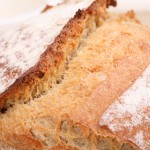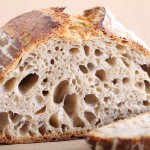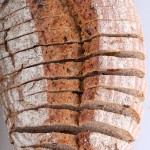
Good pizza: slow dough and fast baking. Hope we can inspire you!
Check out part 1 of our pizza adventure here!
Last weekend it was back to the pizza baking and dough making. Next to sharing some more pizza baking clips live from the Roccbox pizza oven, we also want to dish out our pizza dough making method.
For the pizza dough we use a high gluten (13%) Italian 00 flour with a W factor of over 300. This W factor indicated dough elasticity and extensibility. Around 300 is a sweet spot for long fermented pizza dough.
As a test we made pizza dough with short, medium and long fermentation times. We found the long, fridge retarded dough was best. If you are in a hurry or forgot to make dough, you can make a basic pizza dough in around 2 hours of course. The difference with the long fermented dough is noticeable in depth of flavor and structure, with a different bite. The short fermented dough is more bread-like and baked at the same time and temperature, this dough can seem more compact and almost a bit raw.
So, we want to share with you the recipe for a 24 hour, fridge retarded pizza dough that you might like to try and hopefully like too.
We also had some fun with toppings and crust. We made pizza with truffle cream and greens from our garden which was delicious! Inspired by a Roccbox video, we also made a ‘racket pizza’. You basically use a corner of the crust and stuff it, so you get a pizza and small calzone in one. What’s not to like!
24 hour pizza dough recipe
| Ingredients for the Pizza Dough | ||||
|---|---|---|---|---|
| makes 4 pizza’s | ||||
| 585 | g | Italian typo 00 pizza flour | ||
| 350 | g | water | ||
| 15 | g | olive oil (optional) | ||
| 11 | g | sea salt | ||
| 2.6 | g | instant yeast | ||
Pizza dough method
- Combine all ingredients in the bowl of your standing mixer and knead for 5 minutes (or knead for 10 minutes by hand).
- Take the dough out of the bowl and onto your work surface. Knead by hand for an extra minute to give it a smooth finish.
- Shape into a ball, place in an oiled container, cover and leave to rest for 10 minutes.
- Now do two full sets of stretch and fold.
- Place the dough back in the container and again leave to rest for 10 minutes.
- Now do one full set of stretch and fold.
- Place the dough back in the container and once again leave to rest for 10 minutes.
- Divide the dough into 4 equal parts of around 240 grams and shape into balls.
- place them in a container with enough room for each ball to develop and leave to ferment in the fridge* for around 24 hours.
- You can take the dough out of the fridge around 1 hour before use. We find it’s easier to handle when we do this.
*Our fridge temperature is around 6°C. The amount of yeast and hours in the fridge are based on this. But you do have a bit of leeway with this dough if you need it when planning your pizza baking.
Table percentage of instant dry yeast
| Temp | 4h | 6h | 8h | 12h | 18h | 24h | 36h | 48h |
|---|---|---|---|---|---|---|---|---|
| 4°C | 0.960 | 0.640 | 0.384 | 0.256 | ||||
| 5°C | 0.832 | 0.576 | 0.320 | 0.224 | ||||
| 6°C | 0.640 | 0.448 | 0.256 | 0.192 | ||||
| 7°C | 0.832 | 0.521 | 0.320 | 0.192 | 0.128 | |||
| 8°C | 0.704 | 0.384 | 0.256 | 0.160 | 0.096 | |||
| 18°C | 0.512 | 0.320 | 0.192 | 0.128 | 0.064 | 0.048 | 0.024 | 0.016 |
| 19°C | 0.448 | 0.256 | 0.160 | 0.096 | 0.056 | 0.040 | 0.020 | 0.014 |
| 20°C | 0.320 | 0.192 | 0.128 | 0.080 | 0.048 | 0.032 | 0.016 | 0.012 |
| 21°C | 0.256 | 0.160 | 0.096 | 0.056 | 0.032 | 0.024 | 0.012 | 0.010 |
| 22°C | 0.224 | 0.128 | 0.080 | 0.048 | 0.024 | 0.018 | 0.010 | 0.006 |
| 23°C | 0.192 | 0.096 | 0.064 | 0.040 | 0.022 | 0.016 | 0.009 | 0.005 |
| 24°C | 0.160 | 0.080 | 0.056 | 0.032 | 0.020 | 0.013 | 0.007 | 0.004 |
| 25°C | 0.128 | 0.064 | 0.048 | 0.024 | 0.016 | 0.010 | 0.006 | |
| 26°C | 0.096 | 0.056 | 0.040 | 0.022 | ||||
| 27°C | 0.090 | 0.048 | 0.032 | |||||
| 28°C | 0.064 | 0.040 | 0.024 |
How to use the table
For example: Take 585 grams of flour for 24 hours in the fridge at 6°C.
Look in the table at 6°C and 24 hours, there you see the bakers percentage of 0.448
This means you can calculate the ammount of yeast by:
585 grams of flour divided by 100 = 5.85
5.85 times 0.448 = 2.62 grams of yeast.
White pizza with courgette and garlic
Simple pizza with mozzarella, basil and pepperoni
Simple pizza with mozzarella, basil and pepperoni
Racket pizza, the folded handle is filled with mozzarella and pepperoni. Calzone and regular pizza in one!
Our latest baking session we experimented with some new toppings which could quickly become a new favorite. Inspired by recipes on the Roccbox site we first grilled some aubergines in the pizza oven. We then used pieces of aubergine (eggplant), together with mozzarella, fresh Parmesan cheese and a pesto made with jalapeño chili peppers, olive oil, basil and pine nuts as topping. We also made a variation with a tomato sauce base. It was delicious with just the right amount of fiery kick from the peppers.

With leftover dough and pepper pesto and an added hint of garlic we made this naked pizza. Super fun to watch when it bakes. Also great to use this bread as an appetizer, cut into strips.









michael says
Thank you for this very useful post and table. Very happy to discover your blog.
Tony says
Hi
Can you do a four hour Poolish at room temperature with 100% flour and 0.03g of instant yeast? And does it effect the amount of yeast needed for the final dough?
Thanks
Tony
Chris says
First a question, then a hint, and then some feedback 🙂
The question: Do you have some pizza dough yeast-free?
The hint: It will be a good idea to create a category or a tag for “yeast-free” recipes. Many people are allergic to yeast, like me.
The feedback: From a fellow blogger, you are doing an awesome job. I love some recipes and the way you are explaining “the making”. I believe that a better categorization will help your site a lot. One example is the “yeast-free”, “gluten-free”, “wholemeal recipes”, etc. For me, it’s very hard to navigate around looking for specifics and your search option doesn’t help me much.
Without selling your soul, you can also monetize your site waaaaaaaaay better, in case you have any intention. I assume you don’t since there are no Ads either. In case you do, feel free to reach out. Might be able to help.
Cheers
Joe says
which attachment do you use for the mixer, the paddle or the dough hook?
Weekend Bakers says
We use the dough hook Joe!
Cher says
Hi, can I freeze the dough?
Ashley Jones says
I made this last night and it is delicious! Just wondering what is considered one serving for the nutritional information? Is that 2 prepared chicken breasts?
CrazyAsk
Simon says
Researching for tips to make 25 pizzas. I plan on doing a poolish.
I have fresh yeast
How much yeast for 3500f of 00 flour? Would I add yeast to the poolish and not the ‘main dough’?
Chris Whlitelonis says
I would use 1/4 tsp. I always use that amount in my poolish whether I’m making three loaves of bread or six. If it’s slow to rise take the dough out of the fridge.
Nhung says
Hi! Can I do it after 1 or 2 hours instead of 24 hours? Device dough into 4 parts and leave to rest for 1 or 2 hours at room temp and use
GailG says
Hi, in case you start answering comments again, I’d like to know how to convert this recipe using Active dried yeast instead of Instant yeast? Thanks in advance 🙂
NEILL says
from my experience, double the weight (g) for fresh yeast:
dry yeast. 2g. = 4g Fresh yeast
Weekend Bakers says
Thank you for sharing Neil,
There is a ‘rule’ or a general suggestion in baking to multiply x 3 from dry to fresh yeast. Having said that, there is nothing like (personal) experience in baking to find out what works best for you and the given recipe. We have also worked with different amounts of fresh yeast for different recipes and normally, the richer the dough the more (fresh) yeast we use. I think your suggestion should work well for us too for this pizza dough recipe.
Harold Burton says
recipe looks wonderful. i hope you don’t mind but i added this recipe to my site with working links to your page. can’t wait to try this one out!
Harold Burton
Menno says
Dank voor het uitgebreide recept inclusief de gist formule. 2 vragen:
– bij sommige recepten zie ik dat ze eerst de bloem samenvoegen met water en het dan laten rusten voor 30 minuten. De zogenoemde autolyse fase. Hebben jullie hier ook ervaring mee?
– is het kritisch hoelang je het deeg laat rijzen voordat je het in de koelkast doet? Daar lees ik namelijk ook veel variatie in. Soms gaat het na 20 minuten in de koelkast, bij jullie recept na ongeveer 30 minuten en soms laat men het 2 uur rijzen. Ik heb de hoeveelheid gist afgestemd op mijn koelkast van 4 graden (vrij veel dus), het ongeveer een uur laten rijzen met als gevolg dat de pizzabollen enorm zijn gerezen nadat ze uit de koelkast kwamen, het deeg veel te elastisch was en ik er moeilijk een ronde pizza van kon maken.
Shaakirah says
Hello ! Ive followed all instructions but made a huge mistake i forgot to put my yeast in the dough , i only put it in after all the ingredients were already mixed in the machine for about a minute 🙁 carried on and did everything else I’ve left it to rise in Fridge ,its in the fridge for about 11 hours and the balls are not that much bigger does it still rise much more or has it flopped 🙁
Hélène Habets says
Super recept! Gisteravond 20:00 u dit deeg gemaakt met 100% Manitoba meel (had geen ander) en 3 el olijfolie. Stretch & fold in de kom van de Kitchenaid. Koel weggezet. Vandaag om 16:00 u deeg uit de koeling gehaald, 30 min. op temp. laten komen. Geen deegroller nodig, deeg liet zich super uitrekken in de geperforeerde pizzavorm en rees in nog eens 30 min. prachtig. Mijn hetelucht oventje haalt nét de 170 gr.C. – en toch was de pizza in dik 20 minuten heerlijk knapperig, door en door. Dank voor het delen van julli kennis en ervaring.
Gage Parker says
I like your yeast table and I am very interested in a source that would show the formula behind it. I think the math example might be helped with a slight edit or a pair of parenthesis.
“585 divided by 100 times 0.448 = 2.62 grams of yeast”
When I first tried the example on my calculator, it showed I needed 13 grams of yeast! My mistake was due to my assumption that transitivity would apply and I could multiply .448 by 100 and divide that into 585. More clear would be one of these:
(585 times .448) divided by 100
or
(585 divided by 100) times .448
or
Divide 585 by 100 and multiply the result by .448
or
Multiply 585 by .488 and divide the result by 100
Weekend Bakers says
Thank you for this helpful addition. We sometimes forget how many people are challenged by what seem simple calculations.
As shown by your own examples, it does not really matter in what order you do these calculation, first divide or multiply, the outcome is the same.